Amazing Drainage System of the Forbidden City
The 600-year-old Forbidden City has never been flooded. How? It is mainly because of its amazing drainage system. Let’s have a look.
The ground of the Forbidden City is a huge project. It is paved with bluestone bricks, which are more conducive to rainwater penetration than the ordinary concrete pavement. Below the bluestone bricks, is a very thick layer of rammed earth, which can absorb a large amount of water, just like laying a huge sponge underground.
The designers made full use of the terrain to build Forbidden City’s drainage system. Beijing is bordered by Yanshan Mountain in the north and Bohai Sea in the east. The terrain is high in the northwest and low in the southeast, therefore, Beijing’s rivers flow southwestward. The design of drainage system of the Forbidden City is in harmony with the terrain of Beijing. In order to facilitate drainage, the entire Forbidden City is high in the north and low in the south, forming a gentle slope with a height difference of 1.22 meters (4 feet), which makes rainwater flow by itself.
Besides, the terrain on the east and west sides gradually decreases from the royal road in the axis line and forms another slope. The rainwater can flow eastward and westward into the Inner Golden Water River from the axis.
However, the buildings inside the Forbidden City are dense, and the courtyards are encircled by palace walls, which weakens the self-water drainage ability of the Forbidden City. Therefore, crisscross ditches are built on the ground or underground to help the rain water get rid of the block of the palace walls. Usually, the closer the ditch to the central axis, the shallower it is. Usually, the shallow ones are 0.4 - 0.5 meter (1.3-1.6 feet), and the deep ones are 1-2 meters (3.3-6.6 feet). This clever drainage design ensures that the rainwater does not accumulate in any of the courtyards in the royal palace.
Looking up at the square in front of Hall of Supreme Harmony, you can see the palace stands on a three-tier marble terrace with a height of 7 meters (23 feet). Each tire of the terrace is surrounded by many carved dragon heads. After a heavy rain, you can see the spectacular view of ‘Thousands of Dragons Spouting Water’. They are actually gutters of the ditches.
After the rain water gathers into ditches, where does it go? The ditches are connected with the Inner Golden Water River flowing through the Forbidden City. So after gathering in ditches, the water flows into the Inner Golden Water River, then into the moat out of the Forbidden City.
There are three defense lines against the flood outside the Forbidden City. From far to near, they are:
1.Old Beijing City’s Moat, Daming River, Taiping Lake
2.Taiye Lake (today’s Beihai and Zhonghai), Houhai
3.Tongzihe, also known as the Outer Golden Water River or the moat of the Forbidden City
These rivers and lakes are usually used for urban water supply, which can also be used to store flood, ensuring that there won’t be rainwater and torrential flood flowing into the Forbidden City.
It is such a precision-designed drainage system coupled with regular maintenance and timely dredging protects the Forbidden City from flood for 600 years. No matter how heavy the rain is, there is no worry about rainwater accumulation. When the rainy season comes, it is strongly recommended to walk around Forbidden City and have a look of the amazing drainage system in the Forbidden City left by the ancients.
 Further Reading:
Further Reading:
Ancient Alarm System in the Forbidden City
Gutters on the Wall of Palace of Tranquil Longevity
Great Water Absorption Ability of the Ground
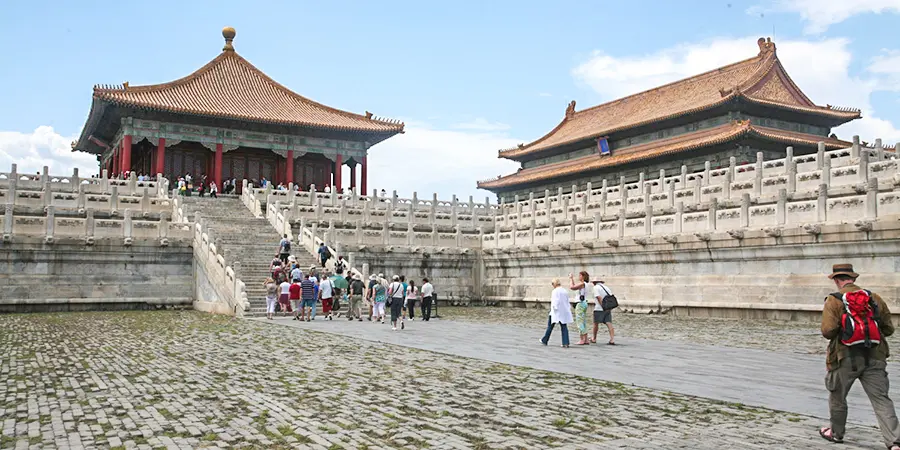 |
| The Ground with Moss in Forbidden City |
Height Difference Ensures the Rain Water Flows Smoothly
Besides, the terrain on the east and west sides gradually decreases from the royal road in the axis line and forms another slope. The rainwater can flow eastward and westward into the Inner Golden Water River from the axis.
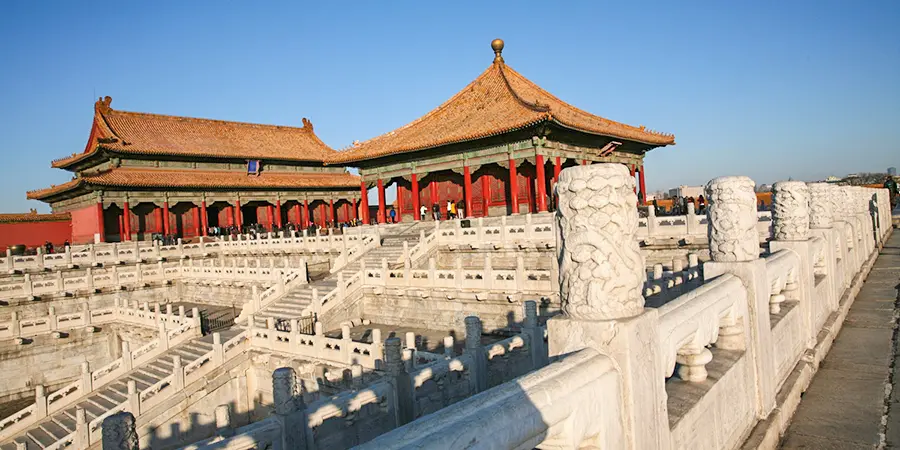 |
| Layered Terrain of Forbidden City |
Ground and Underground Ditches
Looking up at the square in front of Hall of Supreme Harmony, you can see the palace stands on a three-tier marble terrace with a height of 7 meters (23 feet). Each tire of the terrace is surrounded by many carved dragon heads. After a heavy rain, you can see the spectacular view of ‘Thousands of Dragons Spouting Water’. They are actually gutters of the ditches.
After the rain water gathers into ditches, where does it go? The ditches are connected with the Inner Golden Water River flowing through the Forbidden City. So after gathering in ditches, the water flows into the Inner Golden Water River, then into the moat out of the Forbidden City.
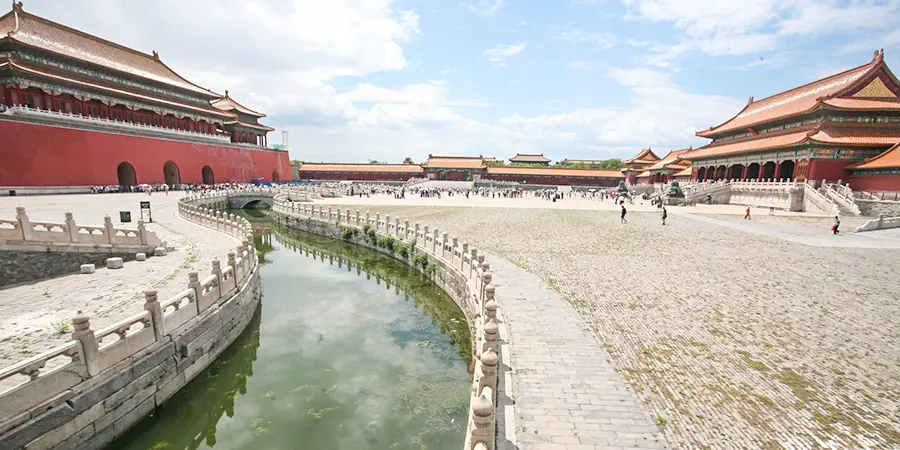 |
| Golden Water River |
Three Drainage Lines outside the Forbidden City
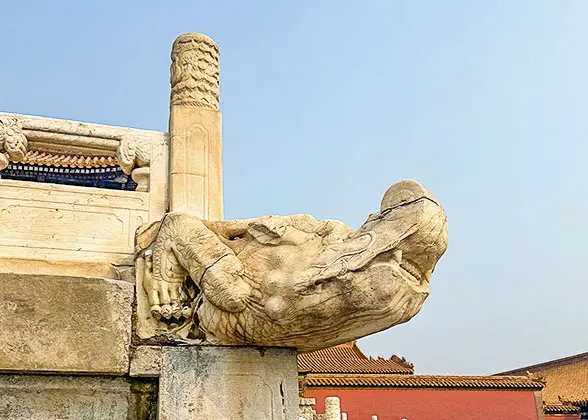 |
| Dragon Gutter |
1.Old Beijing City’s Moat, Daming River, Taiping Lake
2.Taiye Lake (today’s Beihai and Zhonghai), Houhai
3.Tongzihe, also known as the Outer Golden Water River or the moat of the Forbidden City
These rivers and lakes are usually used for urban water supply, which can also be used to store flood, ensuring that there won’t be rainwater and torrential flood flowing into the Forbidden City.
It is such a precision-designed drainage system coupled with regular maintenance and timely dredging protects the Forbidden City from flood for 600 years. No matter how heavy the rain is, there is no worry about rainwater accumulation. When the rainy season comes, it is strongly recommended to walk around Forbidden City and have a look of the amazing drainage system in the Forbidden City left by the ancients.
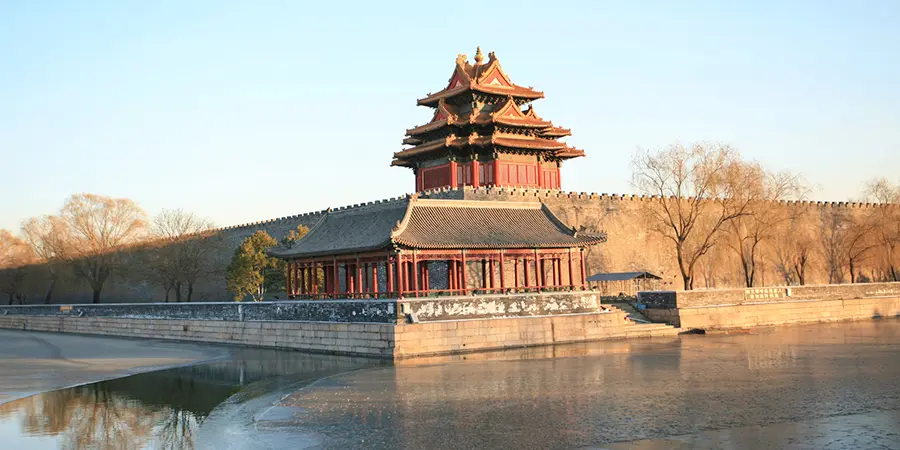 |
| Moat outside of Forbidden City |
Ancient Alarm System in the Forbidden City
Gutters on the Wall of Palace of Tranquil Longevity
- Last updated on Apr. 01, 2025 by Gabby Li -